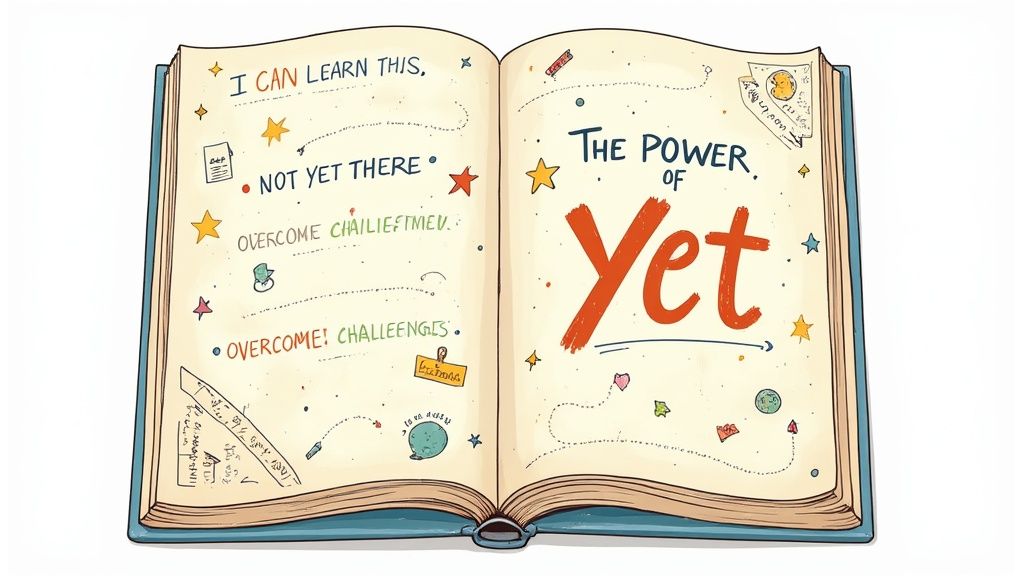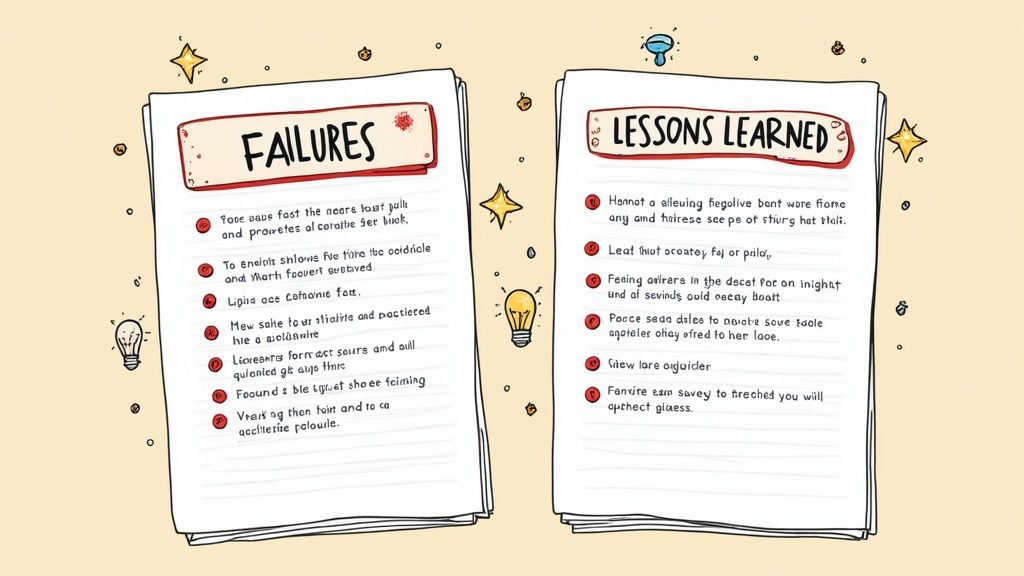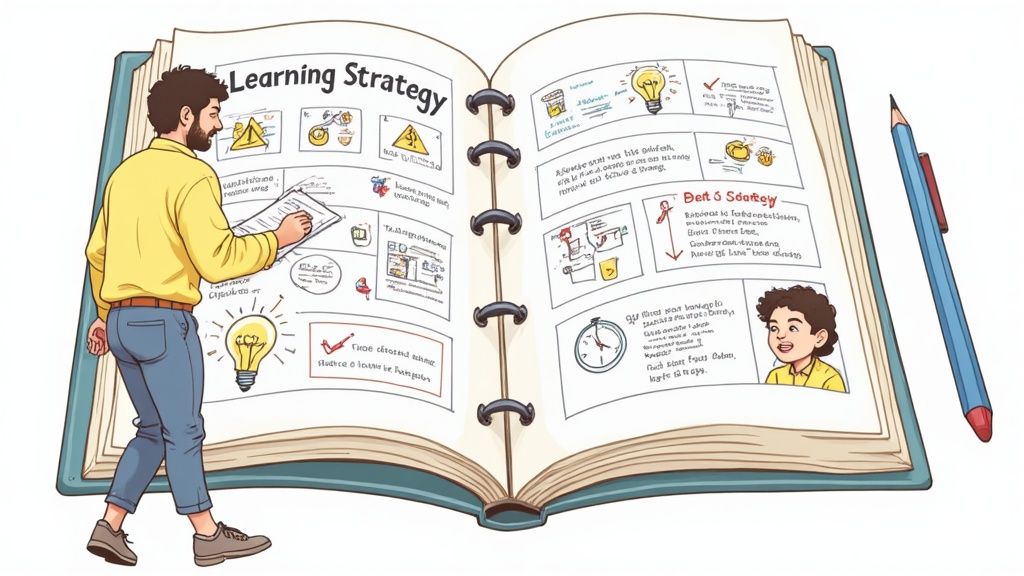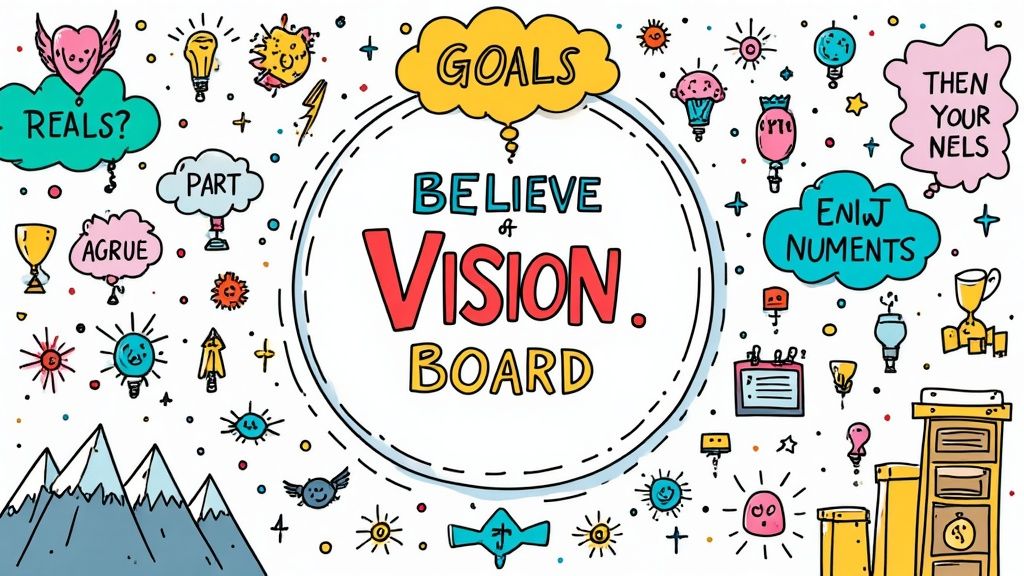10 Growth Mindset Activities for Success


Ready to Grow?
Interested in discovering how to unlock personal development for yourself or empower your coaching clients? A growth mindset, originally researched by psychologist Carol Dweck, represents a real change in how we deal with life's ups and downs. This science-backed concept shows that our abilities aren't set in stone - they can expand through consistent effort and learning.
The practical value of a growth mindset comes from taking specific actions. Rather than just believing you can improve, effective growth strategies focus on building concrete habits that boost resilience and turn challenges into opportunities. These practices help you actively develop your capabilities rather than just hoping they'll magically expand.
This guide presents 10 hands-on activities designed to help you build a mindset focused on continuous development. You'll learn practical ways to transform limiting beliefs, embrace difficult situations with a learning mindset, and gain deeper insights into your personal growth journey. Let's explore how you can create real, lasting changes in your approach to challenges and development.
1. The Power of Yet Journal

The Power of Yet Journal helps people develop a mindset focused on growth and learning. By writing about challenges using "not yet" phrasing, students and others can shift their perspective from seeing failures as permanent to viewing them as temporary steps on the path to success.
This approach builds on research by Carol Dweck, author of "Mindset: The New Psychology of Success". Her studies show that people who believe they can improve their abilities tend to tackle challenges head-on and bounce back better from setbacks. The journal provides a practical way to build this resilient mindset through regular reflection.
Key elements of the Power of Yet Journal include:
- Daily reflection questions that guide self-examination
- Progress tracking to visualize improvement over time
- Growth-focused templates for reframing negative thoughts positively
- Goal-setting sections to connect daily work to bigger aspirations
How It Works in Practice: A student struggling with math might write "I haven't mastered fractions yet" instead of "I'm bad at math." An athlete working on free throws could note "My shot accuracy is improving, though not consistent yet." This small language shift keeps the focus on progress rather than limitations.
The journal offers clear benefits:
- Develops deeper self-awareness through regular reflection
- Creates a record of progress to boost confidence
- Builds positive self-talk habits
- Works well both individually and in groups
Some challenges to consider:
- Requires ongoing commitment
- May feel repetitive for some users
- Needs basic writing ability
Making the Most of Your Journal:
- Schedule regular writing time - consistency matters most
- Use real examples from your own experiences
- Record both struggles and wins to maintain perspective
- Review past entries to see your growth over time
This journaling approach stands out because it offers a simple but powerful way to build resilience and maintain focus on growth. While it does require dedication, the potential rewards - including greater self-awareness, more positive self-talk, and increased persistence - make it valuable for anyone interested in personal development.
2. Failure Resume Exercise

The Failure Resume Exercise helps people embrace their setbacks as learning experiences rather than seeing them as purely negative events. This practical tool encourages documenting and analyzing failures to extract valuable lessons and build resilience. It directly addresses the common fear of failure that often blocks personal growth.
At its core, this exercise involves creating a document similar to a traditional resume, but with an important twist - instead of listing achievements, you catalog your failures and what you learned from them.
Key components include:
- Clear Structure: Organize failures into categories like academic, career, and personal
- Detailed Context: Write out the specific situation and what happened
- Growth Focus: Reflect on key lessons and insights gained
- Future Planning: Document how to apply these lessons going forward
This approach gained wider recognition through Stanford professor Tina Seelig, whose classroom assignment on failure resumes sparked significant interest. The exercise is now used across leadership development, education, and personal coaching.
Benefits:
- Makes Failure Normal: Helps remove the stigma around making mistakes
- Builds Mental Toughness: Develops ability to recover from setbacks
- Creates Growth: Turns negative experiences into useful insights
- Improves Self-Awareness: Develops better understanding of reactions to failure
Challenges:
- Emotional Difficulty: Requires facing uncomfortable memories
- Need for Openness: Must be willing to be honest with yourself
- Support Needed: Some people benefit from guidance in analyzing failures
Implementation Tips:
- Start Current: Begin with recent failures that are easier to examine
- Stay Solution-Focused: Look for constructive takeaways rather than dwelling on negatives
- Keep It Current: Add new failures and review old ones regularly
- Consider Sharing: Discussing with trusted friends can provide new perspectives and emotional support
The Failure Resume Exercise gives people a practical way to change how they view and handle failure. Rather than something to avoid, failure becomes a valuable teacher on the path to growth and achievement.
3. Skill-Building Challenge
A skill-building challenge offers a practical way to strengthen your growth mindset. This focused approach involves setting aside a specific time period, often 30 days, to learn and practice a new skill. By providing a clear structure and timeline, these challenges help build consistency and show real progress over time.
The key elements that make skill-building challenges work include: daily practice commitments, progress tracking systems, visual documentation (photos/videos), and group participation for support. When combined, these elements create ongoing motivation as you see your skills grow day by day.
Social media has made skill challenges increasingly popular, but the science behind them is well-established. Research on deliberate practice by psychologist Anders Ericsson shows that focused, structured practice with regular feedback leads to skill development. Adding a social component through sharing progress helps maintain motivation and accountability.
Here are some popular skill-building challenge examples:
- 30-Day Drawing Challenge: Daily drawing practice focusing on specific techniques
- Language Learning Sprint: Intensive daily language study with clear practice goals
- Musical Instrument Practice: Regular instrument practice tracking mastery of pieces
Pros:
- Shows clear progress: Tracking improvements builds confidence
- Creates accountability: Structure and sharing keep you consistent
- Builds confidence: Seeing results reinforces belief in growth
- Develops resilience: Completing challenges builds perseverance
Cons:
- Time commitment: Daily practice requires dedicated schedule space
- Maintaining motivation: 30-day timeline can feel long when facing obstacles
- Resource needs: Some skills require specific tools or instruction
Tips for Success:
- Pick an achievable challenge: Choose something challenging but not overwhelming
- Track consistently: Document all progress, even small wins
- Connect with others: Share updates for support and accountability
- Celebrate milestones: Acknowledge progress to stay motivated
Skill-building challenges offer a hands-on way to develop a growth mindset. The structured approach, combined with progress tracking and community support, gives you a practical framework for developing new abilities and building confidence in your capacity to learn.
4. Growth Mindset Book Club
A Growth Mindset Book Club provides a structured way to learn and apply growth mindset principles together. Members read selected books, engage in meaningful discussions, and support each other in developing new mindsets and behaviors. The power of combining focused reading with group dialogue creates deeper learning and practical application.
The key elements include:
- Regular Meetings: Set consistent weekly, bi-weekly or monthly gatherings to maintain momentum
- Discussion Questions: Thoughtfully prepared prompts to explore key concepts and insights
- Reflection Exercises: Activities like journaling or self-assessments to connect concepts to personal experience
- Action Planning: Creating specific steps to implement learnings and track progress
Why Start a Book Club?
The social nature of a book club amplifies individual learning. Members benefit from diverse perspectives, mutual encouragement, and shared accountability. Unlike reading alone, the group format leads to richer insights through collaborative exploration of ideas. The supportive environment helps everyone stay motivated and committed to growth.
Examples in Different Settings:
Growth mindset book clubs have emerged across various contexts:
- Workplace Groups: Companies use them to build learning cultures and boost innovation
- Teacher Communities: Educators deepen their growth mindset knowledge to better support students
- Local Organizations: Community groups foster personal development and connection
Benefits:
- Creates supportive learning community
- Surfaces diverse viewpoints and experiences
- Provides helpful accountability
- Deepens understanding through discussion
Challenges:
- Requires coordination effort
- Time commitment for reading and meetings
- Depends on active participation
- Needs skilled facilitation
Tips for Success:
- Choose Relevant Books: Pick titles that match group interests and goals
- Set Clear Guidelines: Define expectations for participation and discussion
- Create Safe Space: Foster open, respectful dialogue
- Make it Interactive: Include activities to boost engagement
- Recognize Growth: Celebrate individual and group progress
When thoughtfully designed, Growth Mindset Book Clubs help people develop new capabilities while building meaningful connections with others on the same journey.
"Growth Story Interviews" -
5. Growth Story Interviews
Growth Story Interviews help build a growth mindset by exploring how real people learn and develop over time. These interviews focus on understanding personal journeys - the challenges faced, skills gained, and lessons learned along the way. By hearing directly from others about their experiences overcoming obstacles, we gain practical insights and inspiration.
The value lies in examining the actual learning process, not just celebrating end results. These interviews dig into the specific struggles, strategies and mindset changes that drive personal growth. Think of it as getting a behind-the-scenes look at someone's development path.
While sharing stories is nothing new, Growth Story Interviews follow a structured approach. Using prepared questions focused on learning helps capture actionable takeaways. The rise of podcasts and online platforms makes it easier than ever to share these experiences with wide audiences.
Key Elements of Growth Story Interviews:
- Structured Format: Carefully chosen questions explore key parts of the learning journey - initial challenges, strategies used, setbacks faced, and major lessons
- Process Focus: Emphasis on how people learned and grew rather than just outcomes
- Strategy Documentation: Recording specific techniques that others can apply
- Distribution Methods: Sharing through written, audio or video formats expands impact
Real Examples:
- A business coach interviews founders about developing their skills, highlighting challenges and solutions
- A teacher records conversations with students who improved their grades through new study approaches
- A career coach talks with successful career changers about their self-discovery process
Benefits:
- Real Examples: Shows growth mindset principles applied in practice
- Builds Understanding: Hearing others' stories creates empathy and connection
- Motivates Action: Inspiring stories encourage embracing challenges
- Creates Community: Brings together people on similar growth paths
Challenges:
- Interview Skills Needed: Requires active listening and thoughtful questioning
- Time Investment: Scheduling and conducting interviews takes effort
- Finding Participants: Need people willing to share openly
Implementation Tips:
- Plan Questions: Create questions that draw out valuable insights about the learning process
- Focus on Journey: Emphasize understanding strategies over just end results
- Seek Variety: Include different backgrounds and experiences
- Share Widely: Distribute stories through blogs, podcasts, social media or group discussions
Growth Story Interviews earn their place on this list by providing an engaging way to learn from others' experiences. By exploring how people actually develop and grow, these conversations offer practical insights and inspiration for anyone working to build a growth mindset.
6. Mistake of the Week

The "Mistake of the Week" approach helps teams build a growth mindset by making it normal and productive to discuss mistakes openly. Rather than hiding errors, team members come together regularly to share missteps, analyze what happened, and identify ways to improve. This practice directly tackles the fear of failure that often holds people back from learning and growing.
The format involves weekly meetings where team members take turns sharing a recent mistake. The discussion follows a clear structure: describing what happened, examining the impact and contributing factors, and developing solutions as a group. Teams then track how well the improvements work over time.
Key Elements:
- Regular schedule: Meeting consistently helps build trust and participation
- Clear discussion format: Keeps conversations focused and productive
- Group problem-solving: Uses the team's collective knowledge to find solutions
- Progress tracking: Shows if solutions are working and maintains accountability
Benefits:
- Makes mistakes acceptable: Creates an environment where errors lead to learning
- Builds trust: Encourages open and honest communication
- Improves problem-solving: Develops critical thinking and teamwork
- Strengthens learning culture: Makes growth a shared team priority
Challenges:
- Requires psychological safety: Team members need to feel secure sharing vulnerabilities
- Can feel uncomfortable: Opening up about mistakes takes courage
- Benefits from good facilitation: A skilled leader helps guide productive discussions
Tips for Success:
- Leaders go first: When leaders share mistakes, it shows vulnerability is valued
- Focus on lessons: Keep discussions centered on learning, not blame
- Use a consistent format: Having a clear structure makes sharing easier
- Monitor improvements: Track progress to show the value of discussing mistakes
Research Background:
The research on psychological safety by Amy Edmondson and Google's Project Aristotle provides strong evidence for why the "Mistake of the Week" approach works. Their findings show that teams perform better when members feel safe taking interpersonal risks.
Real Example:
Consider a marketing team using this practice. A team member shares how a recent social media post received negative feedback due to misunderstanding the audience. The group analyzes what led to the mistake and develops better research and review processes. By tracking results, they see how these changes improve future campaigns.
The "Mistake of the Week" practice helps teams see mistakes not as failures to avoid, but as stepping stones to improvement and growth.
7. Learning Strategy Portfolio

A Learning Strategy Portfolio is a key tool for anyone committed to ongoing personal growth. It helps you understand and track how you learn best, going beyond just accumulating knowledge to truly mastering the learning process itself. By documenting your learning methods and results, you develop meta-learning skills - the ability to understand and optimize your own learning approach.
Think of this portfolio as your personal learning toolbox that grows with you. It contains your proven strategies, favorite resources, and insights about what works best for your learning style. Regular review and updates help you spot patterns in how you learn most effectively.
Essential Elements of a Learning Strategy Portfolio:
- Strategy Collection: Document specific techniques that work for you, from mind mapping to the Feynman Technique for explaining complex topics
- Results Tracking: Rate how well different methods work for you and note what makes them effective
- Learning Resources: Keep links to useful websites, books, courses, and contact info for mentors
- Review Schedule: Set regular times to assess and update your strategies based on results
Real Success Stories:
A business coach found that her client remembered 85% more from workshops after discovering visual note-taking techniques through portfolio tracking. Another learner realized hands-on projects helped them grasp concepts 3x faster than traditional study methods, leading them to seek out more practical learning opportunities.
The rise of personalized learning has shown that everyone learns differently. While traditional education often uses standardized approaches, tracking your individual learning preferences helps you find methods that work specifically for you.
Benefits:
- Custom Learning Path: Build strategies matched to your style
- Organized Resources: Keep all learning tools in one place
- Better Self-Knowledge: Understand your learning process deeply
- Sustainable Growth: Create habits for lifelong learning
Challenges:
- Time Investment: Requires regular maintenance and updates
- Honest Assessment: Must evaluate your methods objectively
- Consistent Effort: Needs ongoing attention to stay valuable
Getting Started Tips:
- List Current Methods: Write down learning techniques you already use
- Try New Approaches: Sample different learning styles and track results
- Record Outcomes: Note what works and analyze why
- Get Feedback: Share your portfolio with mentors or learning partners
By building and maintaining a Learning Strategy Portfolio, you take control of your learning journey and significantly boost your ability to grow and improve over time.
8. Growth Mindset Vision Board
A vision board focused on growth mindset helps turn abstract goals into clear, actionable steps. This visual tool brings your learning goals and development opportunities to life through carefully chosen images, quotes, and progress markers. When used thoughtfully, it shifts you from passive hopes to active pursuit of growth.
Vision boards have evolved from simple artistic projects into valuable tools for both personal and career development. The core idea remains - visualizing goals helps increase focus and motivation. For growth mindset work, this means depicting both end goals (like becoming fluent in Spanish) and the key milestones along the way (completing weekly language lessons).
Key Elements of an Effective Board:
- Visual Goal Representation: Use meaningful images and keywords rather than just text lists. For example, include a photo of someone presenting to represent public speaking goals.
- Progress Tracking: Add visual ways to monitor achievements, like stickers or movable elements to mark completed milestones.
- Motivational Content: Include quotes about perseverance and images of role models to stay inspired during challenges.
- Regular Updates: Review and refresh the board periodically to keep it aligned with your evolving goals.
Real Examples:
- A leadership coach's board might feature images of desired certifications, photos of admired mentors, and client success milestones.
- A developer learning a new coding language could include screenshots of target projects, quotes about problem-solving, and a timeline for course completion.
Benefits:
- Makes Goals Real: Turns abstract ideas into visible, concrete targets
- Daily Reminder: Keeps growth goals visible and top of mind
- Boosts Creativity: Creating the board itself builds creative thinking skills
- Format Flexibility: Works well both digitally and physically
Potential Challenges:
- Can Feel Artificial: Must be created with genuine intention to be meaningful
- Needs Maintenance: Requires regular updates to stay relevant
- Material Requirements: Takes time to gather appropriate images and content
Implementation Tips:
- Be Specific: Include clear learning steps, not just end goals
- Add Time Elements: Set realistic deadlines and milestone dates
- Keep Visible: Place your board where you'll see it regularly
- Review Quarterly: Set times to update goals and track progress
When thoughtfully developed and maintained, a Growth Mindset Vision Board becomes a practical tool for turning aspirations into achievements through ongoing learning and development.
9. Feedback Practice Partners
A key part of growth is learning from feedback. One effective approach is working with a dedicated "Feedback Practice Partner" - someone you meet with regularly to exchange honest, constructive feedback. This structured partnership helps both people improve their ability to give and receive feedback while developing new skills.
Regular feedback sessions create a foundation of trust. Instead of waiting for annual reviews, partners commit to ongoing meetings focused specifically on growth and improvement. Meeting consistently helps build the psychological safety needed for candid discussions.
This partner-based model works well because it emphasizes reciprocal learning. Both people take turns sharing observations and suggestions, practicing how to deliver and act on feedback effectively. Think of it like having a personal growth coach who is also learning and improving alongside you.
Features of Effective Feedback Practice Partnerships:
- Regular Meetings: Set a consistent schedule - weekly, bi-weekly or monthly check-ins maintain momentum
- Clear Structure: Use frameworks like "Start, Stop, Continue" to guide productive discussions
- Active Development: Practice giving feedback skillfully and receiving it non-defensively
- Progress Tracking: Connect feedback to specific goals and measure improvements over time
Real-World Example:
Two project managers, Sarah and David, become feedback partners meeting every two weeks. Using the "Start, Stop, Continue" method, Sarah notes that David excels at launching projects with clear direction (Start), but interrupts others during brainstorming (Stop), while maintaining strong status updates (Continue). David provides input on Sarah's delegation approach. Their structured exchanges help both identify growth areas.
Pros:
- Improves Feedback Skills: Regular practice enhances ability to give and receive feedback
- Creates Follow-Through: Partnership provides built-in accountability
- Strengthens Connections: Sharing openly builds trust between partners
- Develops Communication: Learning to exchange feedback clearly improves overall communication
Cons:
- Need Reliable Partner: Success depends on finding someone equally committed
- Schedule Coordination: Regular meetings require ongoing calendar management
- Occasional Conflicts: Life events may disrupt planned sessions
Tips for Implementation:
- Align on Process: Define goals, feedback approach and meeting cadence upfront
- Be Specific: Share concrete examples rather than general comments
- Listen First: Focus on understanding before responding
- Track Progress: Review past feedback and changes in future sessions
This approach earns its place because it offers a practical way to build feedback skills. Through dedicated practice with a committed partner, people learn to exchange feedback effectively while supporting each other's growth.
10. Challenge-Response Mapping
Challenge-Response Mapping helps people think strategically and solve problems by visually mapping out potential difficulties they may face, exploring different ways to handle them, and finding opportunities for growth. This method helps build resilience by shifting from reactive problem-solving to thoughtful preparation.
The technique uses clear visual diagrams to brainstorm multiple responses to each challenge and connect them to specific growth opportunities. It includes practical action planning steps to turn insights into concrete actions. You can think of it like a practice run for difficult situations, allowing you to rehearse responses before facing real challenges.
Key Features:
- Visual Format: The diagram layout makes it easy to see connections between challenges, responses, and growth areas
- Multiple Solutions: Encourages exploring many possible responses rather than just one, building adaptability
- Growth Focus: Explicitly connects responses to learning opportunities to build a growth mindset
- Action Steps: Includes specific tasks and timelines to put insights into practice
How to Use It:
- Define the Challenge: Clearly describe the specific situation or obstacle you want to address
- List Potential Responses: Write down different ways you could handle the challenge
- Find Growth Areas: For each response, identify skills or knowledge you could develop
- Create Action Steps: Write specific actions to implement your chosen responses
Real Examples:
- Job Search: Map interview questions (challenges), prepare strong answers (responses), and identify skills to develop like public speaking
- Project Planning: Map project risks, create backup plans, and spot team skill gaps to address
- Personal Growth: Map procrastination challenges, list productivity strategies, and target qualities like discipline
Benefits:
- Better strategic thinking
- Advanced preparation
- Ready response options
- Less anxiety
Limitations:
- Takes time to create
- May not capture complexity
- Needs updating over time
Tips for Success:
- Start Simple: Begin with common challenges you often face
- Get Input: Ask others for different perspectives and ideas
- Update Regularly: Review and revise as situations change
- Share with Mentors: Get feedback on your maps from advisors
The value of Challenge-Response Mapping comes from its structured approach to problem-solving that builds confidence and capability. By thinking through challenges ahead of time, you develop the mental tools to handle difficulties more effectively when they arise. This makes it an essential method for anyone working to grow personally or professionally.
10 Growth Mindset Activities Comparison
| Activity Title | 🔄 Complexity | ⚡ Resources | 📊 Outcomes | 💡 Ideal Use Cases | ⭐ Key Advantages |
|---|---|---|---|---|---|
| The Power of Yet Journal | Moderate – Consistent, reflective writing required | Basic writing tools or digital journal | Enhances self-awareness and tracks progress | Personal growth, classroom reflection | Builds positive self-talk and creates a tangible record |
| Failure Resume Exercise | Moderate-High – Requires guided, vulnerable reflection | Resume template and reflective guidance | Destigmatizes failure and boosts resilience | Workshops, leadership training, personal development | Promotes learning from setbacks and emotional intelligence |
| Skill-Building Challenge | High – Demands daily commitment and structured practice | Significant time, tracking systems, possible equipment | Demonstrates visible improvement and accountability | Intensive skill practice programs, community challenges | Builds persistence and boosts confidence with evidence |
| Growth Mindset Book Club | Moderate – Needs coordination and active discussion | Books, meeting space, and facilitator support | Broadens perspectives and deepens understanding | Corporate, educational, and community learning groups | Builds community and fosters rich insights through discussion |
| Growth Story Interviews | Moderate – Involves coordination and interviewing skills | Recording tools and preparatory materials | Offers inspiring real-world examples and develops empathy | Media projects, mentoring programs, personal growth initiatives | Inspires through storytelling and strengthens connections |
| Mistake of the Week | Moderate – Requires trust and a structured sharing process | Meeting space with skilled facilitation | Normalizes mistakes and enhances problem-solving | Team meetings, peer review sessions, building learning cultures | Cultivates psychological safety and continuous improvement |
| Learning Strategy Portfolio | Moderate – Needs ongoing self-reflection and updates | Documentation tools and regular review time | Personalizes learning approaches and improves meta-learning | Self-directed learning, professional development, strategy tracking | Creates a tailored resource library for long-term growth |
| Growth Mindset Vision Board | Low-Moderate – A creative task with simple setup | Visual materials, digital or physical board | Provides a tangible daily reminder for goals | Goal setting, inspirational displays, classroom activities | Makes goals visible and stimulates creative thinking |
| Feedback Practice Partners | Moderate – Involves scheduled sessions and mutual commitment | Structured feedback format and regular meeting times | Enhances feedback skills and improves communication | Peer coaching, workplace development, mentorship groups | Builds relationships and accountability through regular exchange |
| Challenge-Response Mapping | High – Demands detailed mapping and periodic updates | Visual mapping tools and dedicated planning time | Develops strategic thinking and prepares for challenges | Career planning, project management, personal growth strategies | Facilitates proactive planning and reduces anxiety |
Embrace the Journey of Growth
The 10 growth mindset activities we've explored provide an essential foundation for personal development. From using a "Power of Yet" journal to reframe limitations to creating a "Failure Resume" to understand setbacks, these practices share a fundamental truth: our abilities and intelligence can grow through dedicated effort. By practicing these activities regularly, you'll develop stronger resilience, welcome new challenges, and tap into more of your capabilities.
Start small by adding one or two activities into your daily or weekly routine. Pay attention to what works best for you personally - there's no one-size-fits-all approach. Take time to reflect on your progress, notice areas where you want to improve, and adjust your practices accordingly. The key is finding methods that resonate with your learning style and goals.
Current research shows growing connections between mindset development, emotional awareness, and overall performance. As our understanding expands, new approaches emphasize personalized growth paths and evidence-based tools to support mindset changes.
Key Takeaways:
- Growth is a process, not a destination: Celebrate small wins and keep moving forward
- Challenges are opportunities: See setbacks as chances to learn and build resilience
- Effort and perseverance are key: Consistent practice leads to meaningful growth
- Reflection and adaptation are crucial: Review your progress and refine your approach
Ready to explore more about growth mindset and expand your coaching skills? Visit Coaching Hub for practical insights, proven techniques, and inspiring stories to support your development journey. Our blog provides valuable resources for coaches and anyone committed to ongoing personal growth.